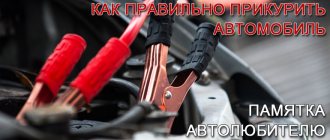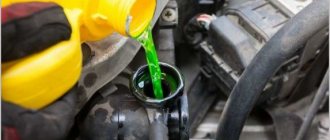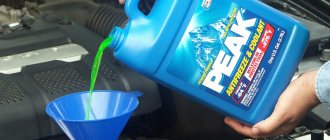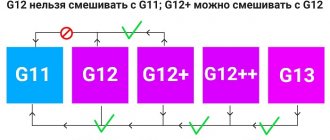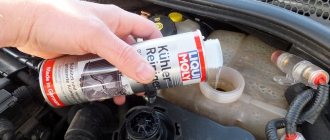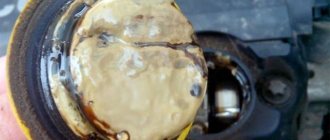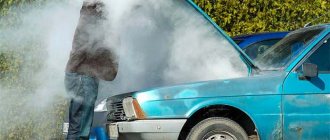The modern market offers a huge selection of antifreeze from various companies with individual characteristics in composition, color and other properties.
Car owners rarely pay attention to the features of coolants and mindlessly mix them. They should not do this, because if the rules established by the manufacturer are violated, the parameters of the coolant may deteriorate and it will not protect the power unit from overheating.
In this article we will look at what the characteristics of antifreeze are and how they differ. Let's talk about the factors influencing the occurrence of corrosion. We discuss the features of European-made coolants and the principles of antifreeze compliance.
We give separate recommendations for mixing antifreezes of different colors with each other, with water and with Antifreeze, we give advice on compatibility and refilling.
Possible consequences of incorrectly mixing antifreeze
Briefly about some brands of antifreeze:
- They can be mixed, they are completely compatible.
- They cannot be mixed, they are incompatible.
- They can be stirred, but not for long, and as soon as possible the coolant should be drained, washed and topped up with new coolant.
The last point is suitable for cases when the coolant level drops on the road (for many reasons) and it is not possible to find coolant of a similar brand to top up.
We will talk about all these points in detail later.
Often, incorrectly mixed coolant leads to corrosion of internal system components, reduced service life of engine lubricant due to overheating, an increase in fat content by 3-5%, pump failure and other breakdowns.
To avoid problems, you should follow the mixing rules given in the special table. It is easier to mix coolants of different shades.
What influences the formation of corrosion
Improper mixing often results in poor coolant quality and corrosion. Here, a lot depends on the coolant itself: the additive package and their correct choice.
At first, all coolants provide good protection against rust, but over time, budget formulations lose their properties and decompose. As a result, only water and glycol remain in the cooling system. No wonder this engine is under attack.
This means that there are no problems with regularly replacing antifreeze, even if it is cheap. If there is no need to change the coolant every 6-12 months, it is better to use expensive coolants. But here car owners themselves decide which option to give preference to.
Antifreeze specifications and their nuances, additives used
Knowing the types and properties is very important for mixing coolants correctly. Conventionally, such coolants are of two types: with ethylene glycol or with propylene glycol. Let's look at the differences between them.
Note. The coolant classes listed below are for informational purposes only and not for promotional purposes.
Note: The coolant classes presented below are for informational purposes only and are not intended to be promotional.
Ethylene glycol
Glycol-based antifreezes are divided into four types, differing in composition, service life and characteristics.
Lobridny
Antifreeze marking Lobrid or SOAT. This is the latest development in the field of coolants. Manufactured with the addition of organic inhibitors that protect against corrosion. The composition includes silicon elements to achieve the best effect.
Functions:
- better performance characteristics;
- High price;
- service life up to 10 years;
- compliance with VW specification - TL 774-G / G12 ++;
- shades - lilac, red, purple.
Example: Sintec Unlimited G12++.
Hybrids
A mixed type of antifreeze, in which there is room for inorganic salts (silicates, phosphates or nitrites) and carboxylic acids. His name is Hybrid or HOAT. This type of coolant is preferred by many manufacturers such as BMW and Chrysler.
Differences:
- Specification N600 69.0 (very similar to G11);
- Specification Opel-GM 6277M is used for Opel cars, for BMW - GS 94000;
- Shades are different (red, orange, yellow, blue, green and others).
Example: Sintec Ultra G11.
Carboxylate (G12+)
A special feature is the presence of organic type inhibitors. In the VW (Volkswagen) specification it is designated as TL with 774-D (G12, G12+) or 774-F/G12+ depending on the type of dye (red or lilac with magenta respectively).
Such coolants have been produced and used by the developer since 2003. In international practice they are designated as OAT.
Key Features:
- resources - from three to five years;
- used only on new cars, the design features of which require the use of only such antifreeze;
- when switching to the old version of G11, flush the cooling system with distilled water, and then with a new coolant concentrate, replacing the sealing elements and pipes.
Example: “Niagara” G12 + (carboxylate) (red) 5 kg.
Traditional (G11)
A classic version of coolant with inorganic inhibitors. In the VW specification, antifreeze is known as G11, and in world practice - IAT. Designed for cars with older type engines made of copper or brass.
Functions:
- low price;
- Service life - two to three years (sometimes more);
- additives - borates, nitrites, salts of phosphoric / silicic acids;
- popular colors - blue, green;
- The dependence of properties on shading is small.
Example: Lukoil G11 Green.
Propylene glycol (G13)
Propylene glycol-based coolants have become very popular due to their increased durability and safety for nature and people. Produced since 2012. It is often used in CO supercharged engines in sports cars.
Advantages:
- Protection against lumps in frost below 0.
- No risk of corrosion inside the mechanism.
- High stability and possibility of continuous operation of the engine.
- Color: yellow, orange.
Example: Volkswagen G13.
Studies conducted in the United States have shown that at high temperature/pressure, coolants are 10 to 15 percent more effective than ethylene glycol-based antifreeze.
Moreover, these drugs do not cause destruction of any engine components, and their chemical activity is often neutralized by additives. Propylene glycol-based liquid is most often viscous and homogeneous. It is non-toxic and does not pose a health hazard.
Antifreeze
Antifreeze is placed in a separate category. How this coolant appeared is beyond the scope of our article, but it is worth saying that it was developed in the USSR as an alternative to foreign antifreeze. The fluid consists of additives and ethylene glycol.
Initially it was created only for VAZ cars. Today this product is not produced and is often called antifreeze under “antifreeze.”
What color is antifreeze?
Today the market offers dozens of types of coolants. It was in the Soviet years that car owners did not know any other options other than “antifreeze”; now, when looking at the counter of a car store, it’s easy to get confused. To simplify the selection process among the mass of proposals, manufacturers introduced a unified coolant classification system: TL 774. Initially, the classification was born within the Volkswagen concern, but quickly spread to the entire global market for products in the segment.
According to TL 774, the following classes of antifreeze are distinguished: G11, G12, G12+, G12++, G13. G11 is almost always green; G12, G12+ - red; G12++, G13 - purple coolants of the latest generation.
Blue (antifreeze)
The color of antifreeze familiar to Russian people is blue. It was blue that was used to paint the first Soviet silicate coolant, “antifreeze.” This was done so that the car owner could determine the degree of its production by the change in the color of the technical fluid, and take care of flushing and replacing the cooler in time.
“Antifreeze” is produced from a mixture of ethylene glycol, water and inorganic additives: silicates, nitrites, phosphates, amines and their combinations. The service life of inorganic inhibitors is up to 2 years, and the permissible operating temperature limit rarely exceeds 105–108 degrees. Modern internal combustion engines operate at higher temperatures, so with such coolant the engine will fail very quickly.
Antifreeze contains 20% distilled water, and the rest is ethylene glycol.
Advantages of "antifreeze":
- Low price.
Disadvantages of "antifreeze":
- Low boiling point;
- Inorganic additives harmful to surfaces;
- Service life - up to 2 years.
Green (G11)
Hybrid antifreeze G11 is tinted with green dye of varying saturation, less often yellow or turquoise. It is based on the same ethylene glycol with water and inorganic inhibitors, but less active than in antifreeze.
Silicates and phosphates in green antifreeze are less dangerous than “Soviet” ones, but this class of coolants is rarely allowed for use in engines of the latest generations.
G11 antifreeze is usually green in color, but can be yellow, turquoise and even blue.
Pros of G11:
- The phosphate film protects the internal walls of the unit from the corrosive effects of ethylene glycol;
- The boiling point is below operating temperature in car engines older than 10 years.
Cons of G11:
- Phosphate film reduces heat dissipation;
- The protective coating crystallizes and crumbles over time;
- Service life - up to 3 years.
In terms of price, green antifreezes are not far from “antifreeze”, so they are often chosen for servicing domestic cars or old foreign cars.
Red (G12)
Carboxylate antifreeze G12 is tinted red - from pale to rich burgundy. The anti-corrosion additives in them are of organic nature - they are synthesized from carboxylic acids. Carboxylate inhibitors work in a targeted manner: they do not cover with a protective film the entire internal surface of a car engine, but only areas with incipient corrosion. Moreover, the coating is so thin that the coefficient of heat transfer to the external environment is practically not reduced.
According to Volkswagen representatives, red antifreeze is considered the optimal solution for most internal combustion engines.
G12 antifreeze does not protect aluminum radiators from oxidation, however, for copper or brass, red antifreeze is the best choice.
Pros of G12:
- Targeted impact on corrosion sites;
- No effect of crystallization of the protective film;
- Can be changed no more often than once every 5 years.
Cons of G12:
- Additives do not prevent the appearance of corrosion foci, but only act locally on existing damage to the surface of the unit;
- Carboxylate mixtures are not effective in protecting aluminum radiators.
At the time of its first appearance on the market, red antifreeze G12 and its modification G12+ were considered a major breakthrough in the development of effective automotive coolants. Compared to examples from previous generations, the disadvantages of carboxylate antifreeze do not seem significant.
Purple (G13)
Lobride antifreezes G12++ and G13 are painted purple. They were invented relatively recently - in 2012. The product is based on practically harmless dihydric propylene glycol and organics, supplemented with mineral additives to protect and enhance the effectiveness of the composition.
Organic silicates are used to create a protective film with a porous structure that prevents overheating of the walls of the unit. Carbon inhibitors work in a targeted manner - they accumulate in places where corrosion starts and prevent it from spreading further.
Unlike previous coolants, G13 class antifreezes contain a propylene glycol base
Pros of G12++ and G13:
- Infinite service life, provided that it is filled into a new engine;
- Less environmentally hazardous composition of the base and additives;
- High boiling point - from 135 degrees.
Disadvantages of G12++ and G13:
- High price.
In fact, additives of different colors are different generations of coolants. Those invented earlier are more dangerous for the environment and less effective when compared with more modern developments by automotive chemical manufacturers.
About European manufacturers
There are many questions about Europe and the quality of coolant from the EU. Today, 90% of the market is occupied by BASF, which has been producing G11 and G12 concentrates for a long time. These products are called Glisanthin.
For other brands such as Castrol, Mobil, Addinoil and Agip, they buy BASF concentrate, mix it with water and ethylene glycol and then supply it to the market. This proves that the base of European antifreezes is almost always identical and mixing them will not have critical consequences.
General Specification
It should be remembered that in the CIS the most popular specification is Volkswagen. The protocol code is TL-774. Coolants are divided into the following categories: C, F, G, J and H. Other designations with the first letter G are more common on the market - 11, 12, 12+, 12 ++ and 13.
In addition to VW specifications, there are other markings specific to other brands:
- General Motors - GM 1899-M, GM 6038-M;
- Hyundai-Kia - MS591-08;
- Ford - WSS-M97B44-D;
- Mercedes-Benz - 325.3, etc.;
- Renault - 41-01-001 / -T type.
Example: CoolStream NRC.
Specifications also vary depending on the country where the coolants are manufactured.
Each country has its own “GOST”:
- Australia - ONORM;
- Germany - FWHEFTR-443;
- GERMANY - FWHEFTR-443; GERMANY - FWHEFTR-443; NORWAY - AFNORNFR 15-601;
- Japan - JISK-2234;
- Italy - CUNA;
- UK - BS6580: 1992;
- Russia - GOST, etc.
Developers in Russia and Asia rarely take into account the current rules. For example, TCL has two shades of red and green, typical of G11, but with different additive levels. Therefore, game developers introduced color separation to avoid errors. This eliminates mistakes when purchasing.
When considering options, consider the colors of refrigerants and their impact on a number of characteristics:
- Rust protection. Plain Tosol does not provide sufficient rust protection. The green-purple color of antifreeze provides reliable engine protection against rust.
- Freezing temperature. The main parameters range from -20 to -40 degrees Celsius. Therefore, conventional and hybrid coolants freeze already at 0 degrees Celsius, which impairs engine performance. Labrid and carboxylate compositions are more attractive here.
- Boiling point. High-performance coolants better protect the engine from overheating under heavy loads. Green and blue coolants boil at 102-110 degrees Celsius. For modern cars this is not enough, so it is better to use purple coolant with a boiling point of 135-137 degrees Celsius.
Antifreeze compatibility
The main rule that you should pay attention to when choosing antifreeze is whether it is possible to mix liquids of the same class produced by the same company.
This is due to differences in manufacturer technology and additives used. In addition, various chemical reactions can occur during the mixing process, as a result of which certain properties of the antifreeze are smoothed out.
It should be noted that almost all classes of coolants are mixed. But there is one exception.
Do not mix G11 with G12 or G12+.
Other options are allowed for short-term use. In other words, replace the antifreeze as soon as possible.
Why is there such a ban when European refrigerants have the same basis?
Everything is very simple. G11 contains silicate additives that prevent rust in the cooling system. This effect is achieved by creating a special protective layer (film) inside the CO elements. Due to this specificity, the shelf life of the product is 24 months. Once the coolant has been drained, it must not be added.
As for G12 and G12+, these antifreezes do not contain film-forming silicates. However, they contain inhibitors that cannot be reused in the same way. Violation of this principle leads to poor protection of the cooling system from corrosion. It can take up to five years from filling to replacement.
What to look for when buying a cooler
When buying antifreeze, pay attention to the following points:
- temperature indicators;
- lifetime;
- color.
To keep your car in good condition, you must choose your coolant responsibly. Experiment less when choosing which antifreeze you can mix with each other. When purchasing a cooler, choose those characteristics that are suitable specifically for your car.
Any car enthusiast understands the need to use non-freezing liquids in the cooling system. One of the most common antifreeze options is antifreeze based on ethylene glycol or propylene glycol (modern modifications). Manufacturers offer mixtures of different colors and chemical compositions, therefore, quite justifiably, questions arise - what is the difference between red antifreeze and green, are they interchangeable, can they be mixed? To understand them, you need to have a general understanding of each of the proposed types of antifreeze coolant.
It is worth saying that we will talk about certified products, the production of which is carried out by a number of well-known companies. For the counterfeit products that fill our market, it is simply impossible to determine the composition, color, or find out the real properties.
Most of the existing antifreezes are based on an aqueous solution of ethylene glycol, which ensures use at temperatures down to -40 0 C. The share of this substance in any coolant of this type is 80-90%, which is why the products of all manufacturers are largely similar.
The main differences lie in the 10-20% additives that protect the cooling system components from corrosive processes. The composition of these additives differs among all manufacturers and in most cases it is considered a trade secret. It is possible to determine only the group of substances added to the ethylene glycol solution. And the color of the liquid can help with this.
Why is it dangerous to mix different brands of antifreeze?
The external differences between refrigerants of different brands are only in color. The same shade is considered to indicate the possibility of mixing due to the identical composition. But that's not true.
Manufacturers may use different approaches to create antifreeze when producing products of the same color. Therefore, when mixing two yellow coolants, you cannot be sure that it is safe. It may turn out that you mixed completely incompatible drugs.
As mentioned, the refrigerants used in a system can differ in many ways (even with the same shades):
- number of additives;
- Properties of additives used (organic, inorganic).
Ignoring the rules can lead to the following consequences:
- The appearance of deposits on parts of the power unit. Different components of the coolant can "conflict", making the coolant thick and limiting the drainage of heat from the system. Over time, the channels become clogged, which leads to overheating of the engine. To protect the mechanism, flush the system and replace the fittings.
- Elements of different antifreezes begin to mutually neutralize each other’s effects. However, if it is necessary to mix coolants of different compositions, prompt flushing and replacement of the coolant is necessary.
- Presence of foam. When mixing coolants of different brands, there is a high risk of foaming. Adding additional additives to “quench” the foam does not have any effect. You should call a service station to rinse and fill with new composition.
Simply put, mixing different brands of antifreeze can damage your engine and its components. Regular violation of the manufacturer's recommendations may even require major repairs.
Traditional technologies
Silicate additives containing silicates. Instead of silicates, borates, nitrates, phosphates, nitrites, and amines can be used. Every manufacturer uses them for their cars. Depending on the materials used in the design of the cooling system. But all these additives have the same principle of action. It consists in the following. If antifreeze gets into the cooling system. Additives begin to coat the inner surface. As a result, a thin layer is created. Which isolates the internal surfaces from the action of ethylene glycol. So, in its pure form, ethylene glycol corrodes the internal surfaces of the cooling system. It also affects rubber products. This is a positive effect of additives.
But traditional technologies have very big disadvantages
Service life of antifreeze in a car
The additives contained in antifreeze precipitate after the allotted time has elapsed. Their place is taken by additives that are in antifreeze and have not yet been used up. They last for no more than two years of operation. Precipitated additives due to liquid circulation. They are lifted by the flow and hit the internal surfaces. This contributes to more intensive formation of sediment and destruction of the protective layer. This further shortens the life of the antifreeze. Leads to destruction of the internal surface of the engine and radiators. That is, the operation of antifreeze using traditional technology should not exceed more than 2 years. Antifreeze needs to be changed and the system needs to be flushed of sediment.
Reduced thermal conductivity.
The second unpleasant moment of antifreeze made using traditional technology. It consists in the protective layer created by additives. Reduces heat transfer from the internal surface of the cooling system. If for old-style engines this is almost unnoticeable. That is the use of various injection and air injection systems in modern engines. Requires more intensive heat removal from engine elements and radiators. Because modern injection systems are both an injector on gasoline engines and a common rail system in diesel engines. Assumes more complete combustion of fuel. Which increases engine power and environmental friendliness. The use of turbocharging leads to an increase in the temperature of the supplied air. By compressing it under pressure.
These two big disadvantages do not allow the use of antifreeze made using traditional technology in modern engines.
Such antifreezes have the following designations
- Antifreeze
- G11
- Traditional coolants
- Conventional coolants
- IAT (Inorganic Acid Technology)
Considering the negative impacts of traditional antifreezes. Another set of additives was developed. Which provides protection against corrosion according to a different principle.
Is it permissible to mix different colored coolants?
There are no hard and fast rules allowing or prohibiting mixing coolants of different shades. In many cases it is possible to mix coolants, but there are times when it is prohibited.
Please note that in most cases the following color reference is used:
- G11 - green, blue;
- G12 / 12 + / 12 ++ - pink, red;
- G13 - orange, yellow.
Let's look at this situation in detail using examples.
Red with green
As mentioned, red coolant can be G12/12+/12++ and green coolant can be G11. There are two steps to identify this opportunity. Firstly, make sure that the refrigerant matches the selected class, and secondly, pay attention to the color. Simply put, you should not mix red G12 with green G11.
Red with yellow
There are no restrictions here, because you most likely need to combine G13 and G12, which is not prohibited.
Blue with green
Both shades correspond to class G11, so they can be mixed, but only if produced in the same factory.
Red with red
Reddish coolants G12 / 12 + / 12 ++ can be mixed without any risk. However, be careful if the product is made by different companies. In such circumstances, mixing is undesirable due to the different composition of the additives and differences in the technology used. In other words, 50/50, depending on luck.
Yellow with yellow
Such coolants are equated to G13, which indicates the possibility of their mixing.
Antifreeze color - how does this characteristic affect the properties and performance of the coolant?
To a greater extent, the color of the refrigerant is a distinctive characteristic. Today, manufacturers do not use color classification, although some companies remain true to this principle.
For example, the Volkswagen company produces antifreezes that differ in color and also have different conditions of use. If we compare the color and class of the liquid, we can distinguish the following parameters:
- G11 - in most cases, antifreeze has a green tint, but may be blue;
- G12 – yellow or red (sometimes bright orange)
- G13 – purple, sometimes yellow.
Other companies also use the color principle, but do not always adhere to the specified scheme. In fact, different colors are used to help drivers differentiate between antifreeze products. There are also companies that simply use different shades to attract the attention of buyers, although the quality and characteristics of the product are the same. Here you can use o or Felix antifreeze.
Antifreeze and antifreeze
Many people wonder whether it is possible to mix modern antifreezes with older types of coolants (toluene). There is only one answer - it is prohibited. The reason lies in the different chemical composition of coolants.
It should be taken into account that when Tosol was created, radiators made of copper and brass were conceived. The composition was selected taking into account this specificity.
Modern manufacturers make aluminum coolers, so the composition of the refrigerant is also different. When mixed, the components of Antifreeze negatively affect antifreeze. In addition, the engine itself suffers: corrosion appears, service life is reduced, and the risk of overheating increases.
Compatibility table for antifreeze of different brands.
| Replaceable coolant | Coolant in the car cooling system | |||||
| G11 | G12 | G12+ | G12++ | G13 | Coolant | |
| G11 | Yes | No | Yes | Yes | Yes | No |
| G12 | No | Yes | Yes | Yes | Yes | No |
| G12+ | Yes | Yes | Yes | Yes | Yes | No |
| G12++ | Yes | Yes | Yes | Yes | Yes | No |
| G13 | Yes | Yes | Yes | Yes | Yes | No |
| Tolsol | No | No | No | No | No | Yes |
What consequences can mixing antifreezes of different shades and manufacturers have?
| Common features | Differences |
Conclusion: if you mix antifreezes of different colors and categories, then with a high degree of probability nothing bad will happen, but do not forget about the nuances. |
Conclusion: if the compositions differ in the type of additives and class, then a conflict will arise when mixing. Such actions can damage the car. |
As a result of what has been written, we can say that mixing antifreeze of different shades is allowed, but you need to act very carefully and taking into account the properties and characteristics of the product.
When the coolant meets a single standard, you can mix substances without much concern. Nothing bad will happen, even if the colors are different. In simple words, mixing refrigerants of the same class is allowed. For greater information, you can present a table on the compatibility of compounds, taking into account their class and standard.
For example, if yellow and purple antifreeze are classified as G13, then you can pour one into the other without any problems. This is due to the fact that the substance is based on propylene glycol, and the additives are almost identical. It turns out that there is only one base, which means there will be no harm when mixed.
Is it allowed to mix Lukoil antifreeze of different brands and colors?
Lukoil is one of the leading manufacturers of automobile oils, flushing fluids, brake fluids and other technical fluids. One of the activities is the production of antifreeze.
At the time of writing the review, the market offered several options:
- G11 Blue is a ready-to-use ethylene glycol-based antifreeze coolant with hybrid technology. The composition includes additional components to protect against corrosion, extend the replacement period of antifreeze, ensure stability of properties and improve heat transfer characteristics. Coolant of this brand can be used in a wide variety of cars.
- G12 Red is a coolant based on carboxylate technology. Suitable for light and heavy vehicles, withstands temperatures from -40 degrees Celsius and above. Guarantees protection against freezing, scale, rust and other problems. Does not have a negative effect on plastic and rubber elements. Free of nitrites, silicates, phosphates and other hazardous ingredients. After pouring, a special layer is formed inside the system, protecting against rust and increasing the service life of the product.
- G11 Green is an environmentally friendly antifreeze based on ethylene glycol. Contains silicates and salts of organic acids to protect against corrosion. This oil is intended for use in closed systems of modern engines. Its distinctive features are frost/corrosion protection, stable properties, low maintenance/repair costs, and versatility in use.
- G12 Yellow is a yellow coolant created using carboxylate technology for use in closed engine cooling systems. Guarantees high protection against corrosion, freezing, scale formation, overheating and other phenomena. The liquid contains carbonic acid salts that protect against corrosion.
- Tosol Super A40 is an antifreeze coolant that contains ethylene glycol and additives to protect against rust, foaming and other problems. Provides effective engine cooling without damaging rubber hoses and seals. Designed for internal combustion engines of cars and trucks.
- HD G12 is a premium antifreeze based on carbonic acid and ethylene glycol. Recommended for use in a wide range of vehicles operating at temperatures below -40 degrees Celsius. It is characterized by high anti-corrosion protection, low freezing temperature and a mild effect on rubber elements. Ensures long engine life and reduces maintenance costs.
- HD G11K is a premium mineral antifreeze based on ethylene glycol and special anti-corrosion additives. It is designed for use in closed cooling systems and can be diluted with water. Advantages: protection against rust and scale, compatibility with seals, engine protection from overheating.
- HD G12K is a high-quality safe coolant consisting of monoethylene glycol and carbonic acid salts. It features the following features: Increased engine protection against corrosion, extends engine life, reduces repair/maintenance costs, has a favorable effect on hoses/seals.
- G11 Green K - antifreeze based on glycol.ethylene in hybrid technology. It is intended for use in internal combustion engines at temperatures from -35 degrees Celsius and above. Guarantees better heat transfer, reduces maintenance costs and ensures stable properties throughout the entire service life. Can be used for various cars.
Many questions relate to mixing different antifreeze options. The same principle as described above should be followed. In particular, it is allowed to mix all types of coolants except G11 with G12.
As for G11 of different colors (blue and green), they differ only in the presence of the FORD ESD M97B49-A additive in the second case, so mixing is allowed.
An additional restriction concerns mixing Antifreeze with antifreeze. These liquids should be used separately.
Mixing different colors and brands
It is possible to mix red and blue refrigerant, green and yellow, as well as other colors of the same or different manufacturers in the heating system if both liquids have the same characteristics. Each antifreeze is colorless before adding dye to the composition. The main difference in the products is not the shade, but the quality itself. One coolant may be designed to protect the cooling system from rust, another for lubricating properties, and a third has a specific temperature range.
All refrigerants can have different freezing and boiling temperature thresholds, and can also be aggressive to metal and rubber elements to varying degrees.
If two liquids that do not match each other in composition are mixed, this is fraught with the following consequences:
- Deposits will begin to appear in the cooling system, which will lead to the formation of a mixture. Because of this, antifreeze will lose its characteristics, which will reduce its service life. As a result of the conflict between different additives, the chemical components refuse to work with each other. The liquid becomes thick and forms a mixture that is unable to circulate normally through the cooling system. Because of this, its lines become clogged and the CO becomes inoperable as a whole, and, as a result, the engine overheats. This problem can be solved by flushing. If cleaning is not done in a timely manner, it will be necessary to replace the pipes.
- It will be worse if the chemical molecules present in the liquid begin to work against each other. As a result, you will not only have to change the refrigerant, but sometimes its elements may fail.
- Foaming will occur. This problem is faced by many consumers who have mixed antifreezes of different compositions and additives. Foam appears in the expansion tank, as well as in the cooling system pipes. There is no point in adding new liquid that has anti-foam additives to the tank. The CO must be completely rinsed several times, and then fresh product must be poured into it.
If the hoses and lines of the cooling system are critically clogged, the following may occur:
- accelerated wear of bearing parts and their destruction;
- failure of the water pump caused by excessive heating of the mechanism;
- overheating of the cylinder head gasket and the engine as a whole, which contributes to deformation and wear of the cylinder head gasket, as well as jamming of the pistons (failure to solve the problem in a timely manner will lead to their failure).
If you constantly use the same antifreeze composition, then your engine will not face problems.
Damaged CO radiator Scale on the radiator unit Deposits in CO CO hoses before and after cleaning
Compatibility check
The most difficult thing for car owners to check is compatibility at home or in the garage. The disadvantage of this method is that it does not give 100% accurate results. But through experimentation, it is possible to determine whether the two types of antifreeze can interact.
To check compatibility, prepare some of the coolant that is poured into the vehicle system during testing and mix it with the one that will be poured.
Algorithm of actions:
- Take a sample with a syringe or use a coolant drain.
- Add the same volume of coolant that is planned to be poured into the system into the container with the coolant being tested.
- Wait 5-10 minutes.
Now pay attention to the reaction of the antifreeze. Factors indicating the negative impact of mixing are foaming and the appearance of deposits.
In such cases, it is better not to mix both types of coolant. To make it more reliable, heat the mixture to a temperature of 80-90 degrees Celsius.
Antifreeze classification
Today, experts classify coolant using the US system. This classification distinguishes 3 different series of antifreeze: G11, G12 and G13.
Type G11 is used most often, the cost of the composition is low. On sale you can find green or blue liquid. They are created on the basis of ethylene glycol with the addition of additives.
Despite the fact that the performance characteristics are not ideal and the service life is short, this coolant is popular among car owners. The reason for this is the low price of the product. By the way, experts also classify antifreeze as G11.
G12 are higher quality compounds made with the addition of various organic substances, such as carboxylate.
Pour such antifreeze into the system if the engine is high-speed and experiences heavy loads. In this case, the cost of the composition will be higher. A red or pink color will help determine that the coolant belongs to class G12.
G13 is the most modern type of coolant, which is made from propylene glycol.
The color will help you understand that you have the highest quality antifreeze: it will be yellow or orange.
In addition to improved performance, such a coolant does not harm the environment, because the composition disintegrates during disposal. Therefore, G13 is the most environmentally friendly antifreeze.
Tips for topping up coolant
To conclude this article, here are some recommendations for adding antifreeze to the cooling system.
Basic moments:
- When adding/mixing coolant, use product from the same container. For example, you buy a large canister and pour a certain amount into the engine cooling system. After this, the container should be stored in the trunk or at home and refilled as needed. When the makeup fluid runs out, it is recommended to flush the circuit and add new antifreeze.
- For vehicles with copper/brass radiators and engines with cast iron blocks, complete the system with G11 (green or blue). This is generally recommended for domestic VAZ cars.
- Any antifreeze can be mixed for short-term use. The only exception is TOSOL, which must be used separately. Also, refusal to use G11 and G It together is associated with the composition and dangerous chemical reactions that can occur inside. When mixed, the resulting coolant loses its effectiveness and/or destroys the rubber elements in the system.
- If it was necessary to mix different types of antifreeze, you should not drive the car for a long time. If possible, flush the system immediately and replace the coolant as recommended by the vehicle manufacturer.
- In extreme situations, when you do not know the type of coolant and its level is below the permissible level, you should add distilled water (up to 0.2 liters) or G12 + antifreeze. These liquids can be mixed with any brand.
- G12 or G12+ in shades of orange/pink should be used for aluminum or "alloy" engines found in many modern cars. For newer cars, the more advanced antifreeze G13 or G12++ is recommended. More information about this can be found in your vehicle's owner's manual.
Following these recommendations allows you to extend the life of the engine and avoid premature repairs.
Carboxylate additives
These are additives based on carboxylic acids. Their use makes it possible not to create a protective film on the inner surface of the cooling system. The absence of a protective layer increases heat transfer between engine elements, radiator and coolant.
The protective effect of carboxylate additives is carried out by neutralizing foci of corrosion, and the formation of a protective layer only in places where corrosion has begun to appear. That is, the effect of additives begins at the moment of formation of corrosion foci. This technology increases the service life of antifreeze from 3 to 5 years. This is definitely a big plus. But what is allowed is the onset of corrosion processes. Makes it impossible to use such antifreeze in engines and radiators made of aluminum.
Engines with cast iron blocks and cylinder heads, as well as brass and copper radiators, do not suffer much harm. Therefore, antifreezes with carboxylic acids are suitable for them.
The following designations are applied to canisters containing carboxylic acid additives:
- G12
- Carboxylate coolants
- OAT (Organic Acid Technology)
As you yourself understand, the use of such antifreeze is excluded in the designs of many cars.
For example, for a GAZ 3309 car with a D245 engine and a brass radiator. It fits perfectly. Since this car uses a common rail injection system and a turbocharger. Antifreeze provides good heat transfer.
But the Gazelle car uses a ZMZ engine made of aluminum and aluminum radiators. Therefore, antifreeze only with carboxylate additives cannot be used. Ethylene glycol will begin to intensively form foci of corrosion. Additives will not cope with protecting the internal surface of the cooling system.
The use of antifreeze made using traditional technologies is also not advisable. Because the engines use an injection system. Which requires good heat transfer.
Therefore, antifreeze has been developed for such cars, which contains additives of traditional technology and carboxylic acids. When using such antifreezes, a thin protective layer of silicate additives is formed, and carboxylic acids come into action in the event of the formation of corrosion. Such antifreezes are called hybrid.
Results
Please note that improper mixing of antifreeze can cause deterioration of the properties of the coolant and, as a result, further problems for the car owner: increased fuel consumption, overheating and reduced engine life, rust on internal components, etc.
To avoid such problems, follow the recommendations given in the article and the manufacturer's requirements.
If different brands/colors of coolant need to be mixed during operation, do so, but if possible, flush the system immediately and add new coolant according to the manufacturer's recommendations.
Therefore, mixing antifreeze with antifreeze and fluids of the G11 and G12 classes should be avoided.
